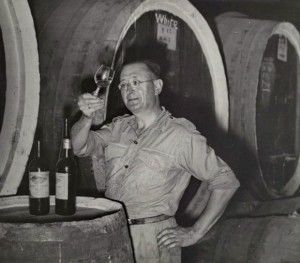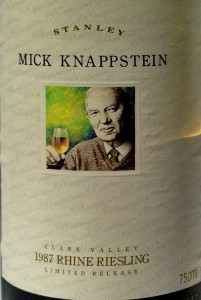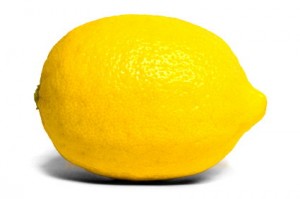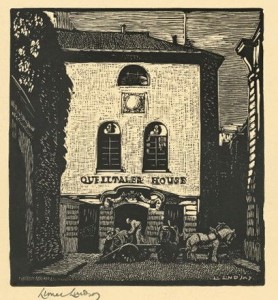Semillon – a Harder Sell than Riesling?
Both varieties have been with us forever, and both are still out on the fringe. Like many other wine writers, I’ve been a vocal supporter of Riesling for decades, yet most people still can’t spell it. Not even wine writers can as this headline in the Telegraph shows: $25 Hunter Valley reisling named the best in Australasia.
Semillon might be easier to spell, but that hasn’t made it easier to sell. Riesling isn’t its natural enemy of course, that’s Sauvignon Blanc. ‘Hunter wine producer McGuigan estimates Sauvignon is selling 3.4 million cases a year in this country,’ Huon Hooke writes in Hunter Valley winemaker launches ‘semillon blanc’, while Semillon is doing about a one-hundredth of that – 40,000 cases. In dollar terms, Sauvignon [Blanc] is worth $438 million compared with Semillon’s $5.6 million.’
What makes Semillon so hard to sell?
‘Semillon is its own worst enemy,’ Ken Sloan at Mistletoe tells Hospitality magazine. ‘For anyone who knows Semillon, it’s your best friend, because it’s very cheap. We need to be able to sell it to the masses. You either give the punters what they want or you educate them.’ Simple, isn’t it?
 ‘It’s a curious state of affairs for a region with such a rich winemaking history that has given rise to legendary names such as Len Evans, Maurice O’Shea, Tyrrell’s, McWilliams’ Mount Pleasant, Brokenwood, Wyndham Estate and Lindemans,’ says Christine Salins, and she’s making a really good point: Hunter Semillon is one of just 2 Australian wine styles that are unique in the world; our Muscats and Tokays are the other.
‘It’s a curious state of affairs for a region with such a rich winemaking history that has given rise to legendary names such as Len Evans, Maurice O’Shea, Tyrrell’s, McWilliams’ Mount Pleasant, Brokenwood, Wyndham Estate and Lindemans,’ says Christine Salins, and she’s making a really good point: Hunter Semillon is one of just 2 Australian wine styles that are unique in the world; our Muscats and Tokays are the other.
I’ve been lucky to have shared some great late sixties / early seventies Lindemans Semillons – variously labelled Hunter Valley Chablis, White Burgundy or Riesling – and some Tyrrells Vat 1 Semillons – also called Riesling – from the same period. At 15 -20 years of age, these are unique and fascinating wines best enjoyed with aged crumbly cheeses. A few of the late seventies Rothbury Semillons drunk at the same age also got my pulse racing.
Young Semillon is a harder sell
Young Semillon can come across as green fruit on an acid trip, and it often takes a decade or two to show the qualities we prize: a fascinating old white with notes of butter, toast, vanilla, honey or mead and nuts. As Campbell Mattinson says: ‘ … Hunter Semillon is the white wine you drink when you’ve gone beyond [the] learner stage and discovered that wine isn’t just fun – it’s fascinating.
 In other words, young Hunter Semillon is a connoisseur’s wine. I could add that it’s a wine mostly appreciated by a few weird people who were introduced to it at an early, impressionable age by Len Evans at Bulletin Place or later the Rothbury Estate. The wine lovers who grew up with Hunter Semillon as their mother’s milk get all teary-eyed with nostalgia and tend to excuse any shortcomings as soon as they recognize the style in the glass in front of them.
In other words, young Hunter Semillon is a connoisseur’s wine. I could add that it’s a wine mostly appreciated by a few weird people who were introduced to it at an early, impressionable age by Len Evans at Bulletin Place or later the Rothbury Estate. The wine lovers who grew up with Hunter Semillon as their mother’s milk get all teary-eyed with nostalgia and tend to excuse any shortcomings as soon as they recognize the style in the glass in front of them.
I’ve been pretty open about my love-hate relationship with Hunter Semillon. You’ll find different styles even in this small area – the green apples style of Mt Pleasant is one that stands out as it develops mouldy straw and wet dog notes with bottle age. The many years the best wines take to blossom can be off-putting, and my impression is that the quality of today’s Semillons is not in the same lofty class as the old wines I was lucky to share many years ago. In the last few years, however, there have been some big style changes as we discuss below.
What wine lovers love about Semillon
 My friend Huon Hooke has no such reservations when he lists 3 reasons why he loves Semillon: ‘First is its appeal at many ages, from brand-new to fully aged (say, 20 years) and at the in-between stages. Second is its suitability (and versatility) with food at every stage of its lifecycle. Because it is a light wine, semillon does not fight the flavours of food; on the contrary, it complements food.
My friend Huon Hooke has no such reservations when he lists 3 reasons why he loves Semillon: ‘First is its appeal at many ages, from brand-new to fully aged (say, 20 years) and at the in-between stages. Second is its suitability (and versatility) with food at every stage of its lifecycle. Because it is a light wine, semillon does not fight the flavours of food; on the contrary, it complements food.
‘And the third feature is that because of its low alcohol, you can drink a surprising quantity without being affected by alcohol. Indeed, Hunter semillon is, like Mosel riesling, one of those white wines that prove that length – or persistence – of flavour does not depend on a certain level of alcohol. Even 10% alcohol Hunter semillons, such as the legendary 1994 Mount Pleasant Museum Elizabeth, have plenty of extract and length.’
No one would question the capacity of good Hunter Semillon to age. In that sense it’s up there with the great Rieslings (Aussies and Germans and Alsatians) and those Marc Bredif Vouvrays which can be hard and sharp in their youth and slowly turn into golden treasures over 25 years.
The Good Old Days and New Young Turks
 A long, long time ago, we had two primary varieties of white in Australia: Riesling and Semillon. To make things even simpler, they were both called Riesling. In South Australia they called Semillon Clare Riesling, and they called the real thing Rhine Riesling. Just to confuse us more, Hunter Valley winemakers labelled their Semillon Hunter River Riesling. No wine needs this kind of handicap.
A long, long time ago, we had two primary varieties of white in Australia: Riesling and Semillon. To make things even simpler, they were both called Riesling. In South Australia they called Semillon Clare Riesling, and they called the real thing Rhine Riesling. Just to confuse us more, Hunter Valley winemakers labelled their Semillon Hunter River Riesling. No wine needs this kind of handicap.
Many reasons have been given for the early picking that results in the low alcohol content of most young Hunter Semillons. When I say early, I mean harvests that begin before New Year in hot seasons and are in full swing in January. One reason is that Semillon loses acid rapidly as the grapes ripen. Picked fully ripe, the wine might lose a lot of its finesse and aging potential, and show its hot climate origins. Picking early avoids that fate.
The second reason often given for the early picking is the fickle summer weather. In contrast to the dry Mediterranean summers of South and Western Australia, the Hunter tends to cop heavy rain, hail and mould resulting from the high humidity there, so Hunter winemakers like to get their fruit in before the weather wreaks its havoc.
Matching Semillon with Food
In my post Australia is Blessed with the Unpopularity of Riesling, I said the unpopularity was a result of people drinking it with the wrong foods, and wine writers suggesting young Riesling made a good match for seafood. Rubbish I said, Riesling is too fruity for seafood, Riesling loves Chicken.
It’s the same with Semillon: we have wine and food writers like Fiona Beckett (in the UK) telling us to drink it with chicken. Match of the week: Mt Pleasant Elizabeth Semillon 2007 and Roast Chicken with Taragon. Chicken and Taragon? Chicken and Semillon? The lady says ‘Semillon tastes of pineapple and pineapple and ham go together so Semillon and ham should be a perfect match, right?’ Pineapple is not a fruit I’ve ever come across in Semillons, and this 8-year old Lizzie is close to maturity and best drunk with a crumbly old Caboolture cheddar.
 Fiona even wrote a post under the heading THE LEMON DILEMMA, where she talks about chicken but never mentions Riesling. Instead she comes up with strange choices like lemony Sauvignon Blanc (which go really well with seafood) and Sauvignon Blanc Semillon blends (also go well with seafood) and even Rioja reds. And her website is called Matching Food and Wine.
Fiona even wrote a post under the heading THE LEMON DILEMMA, where she talks about chicken but never mentions Riesling. Instead she comes up with strange choices like lemony Sauvignon Blanc (which go really well with seafood) and Sauvignon Blanc Semillon blends (also go well with seafood) and even Rioja reds. And her website is called Matching Food and Wine.
Huon Hooke is right: young Semillon goes well with seafood because it’s so crisp and dry and fine and cool and lemony. It lacks the often pungent aromatics of Sauvignon Blanc, and that can be a good thing with oysters and plain, delicate fish grilled or cooked in butter. I suspect it also goes well with Italian dishes because it’s dry and acidic and cleans up oily food really well.
Semillon elsewhere in Australia
 At another time, in a galaxy far away, I used to buy Quelltaler White Burgundy which was a lovely Clare Valley Semillon aged in big old casks. I preferred it to young Hunter Semillons as it was more generous in flavour and proportion, and creamy in texture. Sadly, Wolf Blass bought Quelltaler, Southcorp bought Wolf Blass, and eventually the Annie’s Lane label came out of the corporate meat grinder. No more Semillon, of course.
At another time, in a galaxy far away, I used to buy Quelltaler White Burgundy which was a lovely Clare Valley Semillon aged in big old casks. I preferred it to young Hunter Semillons as it was more generous in flavour and proportion, and creamy in texture. Sadly, Wolf Blass bought Quelltaler, Southcorp bought Wolf Blass, and eventually the Annie’s Lane label came out of the corporate meat grinder. No more Semillon, of course.
There are still some Semillons made in South Australia, but they’re far and few in between and hard to find. We’ve picked Mitchell and Bethany as the best examples, generous Semillons form The clare and the Barossa. Peter Lehmann’s top Semillon is highly regarded but it’s almost as lean as the leanest Hunter Valley jobs. Other labels are Tim Adams, Murray Street and Henschke Louis.
Victoria isn’t Semillon country. Western Australia is, but most of the fruit is blended with Sauvignon Blanc to make a style this state has made its own. Vasse Felix used to make a Semillon but now blends it to make an SSB. Moss Wood still makes a Semillon but it’s over $30. And so it goes.
Additional Reading
Hunter Valley Semillon, a primer by Huon Hooke
Who gets the gong for Semillon? By Ralph Kyte Powell
Semillon lost in the name game, by Philip White
